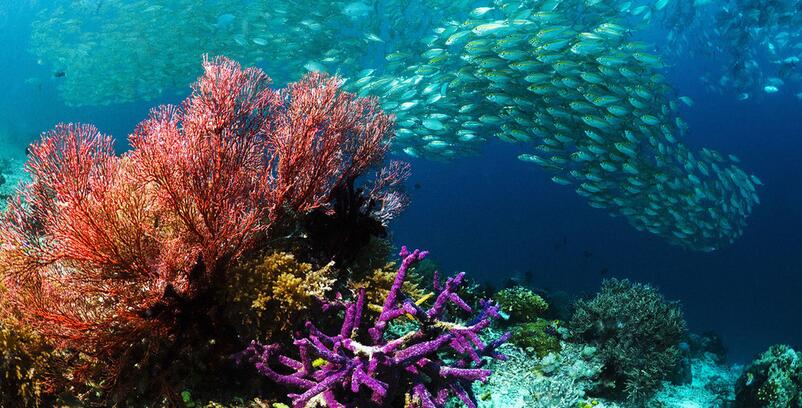Another hypothesized human-related cause is fertilizer runoff.
另一種與人類相關(guān)的假定原因是化肥流失。
People use fertilizer for their crops and plants and a lot of it eventually makes its way from land into the seas.
人們用化肥來種植莊稼和植物,很多化肥最終從陸地流入了海洋。
It's fertilizer, so it has a lot of nutrients.
這是化肥,所以富含營養(yǎng)。
These nutrients have an effect on the starfish, because they cause an increase in the growth of phytoplankton.
這些營養(yǎng)會影響海星,因?yàn)闋I養(yǎng)導(dǎo)致浮游植物大量增長。
Phytoplankton are microscopic plants that grow in the ocean.
浮游植物是微觀植物,生在海洋里。

Larval CoT starfish eat phytoplankton in their first month of life, so more fertilizer in the ocean means more phytoplankton, which means more starfish, bad for the reefs.
年幼的刺冠海星在出生的第一個月以浮游植物為食,所以海里的化肥越多,意味著浮游植物越多,相當(dāng)于海星越多,對珊瑚礁來說就很糟糕了。
Now, the final hypothesis has to do with storm events.
最后一種假說和風(fēng)暴活動有關(guān)。
If some reefs are destroyed by storms, starfish populations that inhabited those reefs would have to condense and concentrate on the reefs that are left.
如果一些珊瑚礁被風(fēng)暴毀壞了,居住在這些珊瑚礁里的刺冠海星就會聚集在剩下的珊瑚礁上。
So this can cause a kind of mass feeding frenzy.
這會引發(fā)某種大規(guī)模瘋狂覓食。
So we have ideas, but no real answer.
所以我們有想法,但沒有真正的答案。
And because we aren't sure of the causes for starfish population increases, it's difficult to prevent them.
且由于我們不能確定海星數(shù)量增長的原因,要預(yù)防就很難了。
I mean, some progress has been made.
我是指,(人們)已經(jīng)取得一定成果了。
For example, new survey techniques have enabled us to detect population increases when the starfish are quite young, so we can be ready for them.
比如說,新的調(diào)研技術(shù)能讓我們檢測到海星尚處年幼時的數(shù)量增長,我們就能做好準(zhǔn)備。
But meaningful progress requires much better evidence about the cause.
但重大進(jìn)步則需要有證明原因的更好證據(jù)。
On the bright side, in all the research being done on causes, we have discovered something related to how starfish populations might affect coral reef diversity.
往好的方面看,在此領(lǐng)域做的所有研究工作中,我們已經(jīng)發(fā)現(xiàn)了一些信息,關(guān)于海星數(shù)量可能會怎樣影響珊瑚礁多樣性。
We think that when reefs are damaged, after a few years, the fastest-growing corals repopulate the areas.
我們認(rèn)為,當(dāng)珊瑚礁受損時,幾年后,長得最快的珊瑚能讓原來的地區(qū)重新長滿珊瑚。
And these fast-growing species can grow over the slower-growing species of coral, denying them light and preventing them from recovery.
這些長得快的珊瑚物種能生長覆蓋長得慢的珊瑚,不讓后者接觸到光,阻止它們恢復(fù)。
However, the faster-growing species are the preferred food of the CoT starfish.
但是,刺冠海星更喜歡吃長得快的珊瑚。
So when an outbreak of CoT starfish occurs, they thin out the fast-growing coral and may give the slower ones a chance to reestablish.
所以當(dāng)刺冠海星數(shù)量暴增,它們會是長得快的珊瑚變得稀疏,可能給了長得慢的珊瑚機(jī)會恢復(fù)過來。
So without the outbreak, the diversity of coral would be reduced.
所以,若沒有(海星)數(shù)量暴增,珊瑚多樣性會下降。










